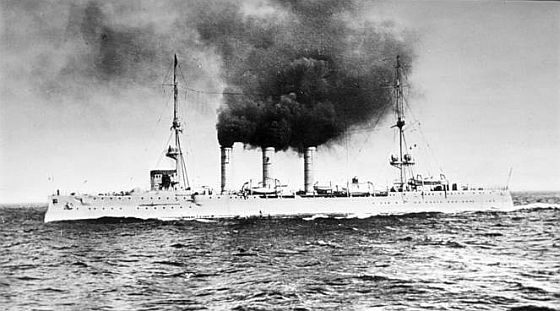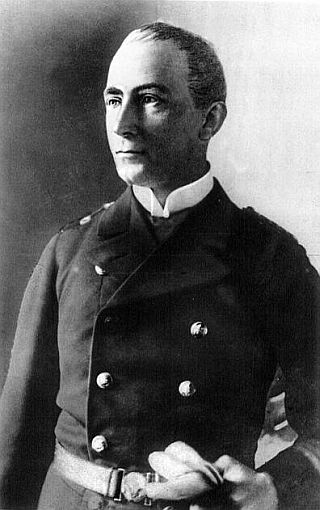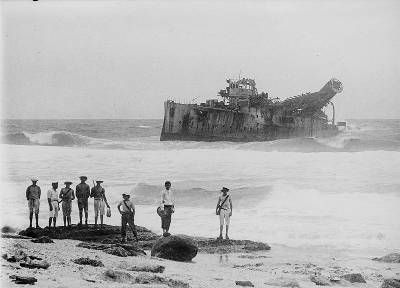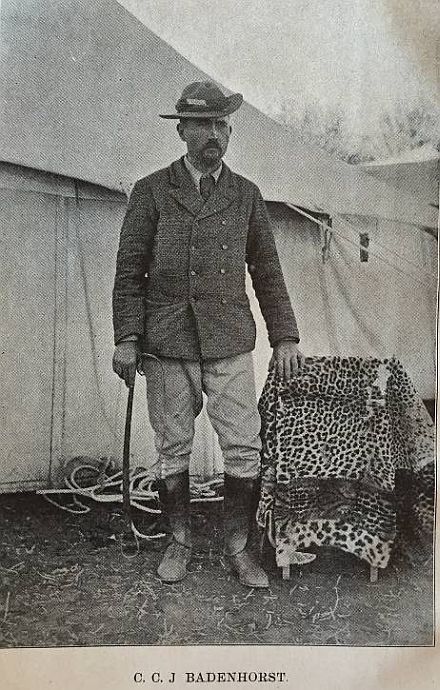


Newsletter No. 485
July 2016
Our two speakers for the June 2016 meeting were Fellow Member Rob Crawley and Dr Arnold van Dyk, who travelled from Bloemfontein to address us. Dr van Dyk is the Chairman of the War Museum of the Boer Republics Trust in Bloemfontein.
Rob’s talk was entitled “The Emden” and dealt with the remarkable voyage of this equally remarkable German warship.

The Emden
The Emden (seen in 1910 in the photo above), nicknamed “Swan of the East” was a light cruiser of the Dresden Class. Displacement was 3 600 tons, length 395 feet, beam 43 ½ foot, her armament ten 4,1 inch, SK L/40 guns, eight 5 pounders, 4 machine guns plus 2 x 17,7 inch torpedo tubes. Her speed 24.5 knots and the Captain was Karl von Mueller under the command of Vice Admiral Graf von Spee.

Captain Karl von Mueller
Captain von Müller convinced his Commander to take Emden with the supply ship Markomannia into the Indian Ocean, with the order to disrupt trade on the various shipping lanes. After several coaling stops they sailed through to the Lombok Straits disguised as HMS Yarmouth with a fourth funnel.
On 7 September the first ship captured was a Greek Steamer with 6 500 tons of coal aboard which they chartered as a supply vessel. For the next 15 days, they sank or captured 9 ships, some of which were used as prison ships. All prisoners and their belongings were transferred to the Kabinga and sent to Calcutta.
The act of releasing this ship contributed to the worldwide fame for von Müller and the Emden.
They then changed course and headed for Madras where they shelled and destroyed the storage tanks of the Burmah Oil Company. During the next six days they stopped six ships. They used one as a prison ship, one as a collier and sank the rest. Prisoners were sent to Colombo in the Greyfevale and again they received excellent treatment.
They then sailed to Diego Garcia where they had a mid-cruise repair and general overhaul.
From October 15 and for the next few days, they captured another eight ships using one as collier and another to transport prisoners to the nearest port. The Emden then set sail to Penang and with the disguise of a fourth funnel and ensign, torpedoed the Russian light cruiser Zhemtchug and sunk her. Next was a French destroyer, the Mousquet. The third salvo penetrated the boiler room and she sank. The Emden rescued thirty six crew members, most of them badly injured.
Their following trophy was the capture of the New Burn and all the wounded French were sent to Khota Raja.
The Emden then arrived at the wireless/cable station on Direction Island. One of the radio operators managed to transmit - “The Emden is here!” The Anzac convoy intercepted the transmission and HMAS Sydney under Captain John Glossop, which was only 50 miles away, was sent to investigate. The Emden put to sea leaving a fifty man landing party behind. She opened fire at 09h40 and the battle lasted 90 minutes. Von Müller beached the Emden to prevent her from sinking.

The Emden beached
The Sydney ceased firing at 11h15, when they hauled down her battle flag and raised a white flag, ending that battle.
The Emden’s landing party under her Executive Officer, Kapitänleutnant Helmuth von Mücke took control of the 97 ton Schooner Ayesha and escaped first to Padang, then sailed to the Red Sea on the German ship then after which they made their way overland to Turkey and home to Germany, a journey that took 6 months.
Every officer who served on the Emden was awarded the Iron Cross First Class and 50 enlisted men received the Iron Cross Second Class. Captain von Müller himself was later presented with the Pour Le Merit.
In their 3 month cruise of 30 000 miles, the Emden sank eighteen merchantmen, converted another to an Armed Merchant Cruiser, used three Colliers, raided two Allied Ports, sank a Cruiser and a Destroyer – a total of 24 ships, as well as causing major disruption to shipping whilst tying down a large number of enemy warships. This amounted to approximately 70,825 gross register tons (GRT) at a value of £15 million.
Throughout her voyage, she had maintained an excellent reputation for her ‘gentlemanly’ behavior. Not a single person from the merchant ships she sank was killed and prisoners were treated with dignity and released at the earliest opportunity.
Some years later, by decree of the German Government, every member of the Emden Crew was allowed to hyphenate his name and add ‘Emden’ to it, which of course was considered to be a great honour!
Dr van Dyk’s talk was entitled “General CCJ Badenhorst in the Western Free State during the guerrilla stage of the Anglo-Boer War”. Drawing from a vast collection of primary source material in his and the Museum’s collection, Dr van Dyk began with the background to this lesser known Boer leader.
Genl. C. C. J. Badenhorst was one of the representatives of the Free State that voted against peace at Vereeniging. The others were Comdt. C.A. Van Niekerk (Kroonstad) as well as Comdt. J.A. Bester (Bloemfontein). The 3 representatives of the ZAR who also voted against peace, were J.F. Naude (Pretoria as well as loose commando under General Koos De La Rey), Comdt. J.J. Alberts (Standerton/Wakkerstroom) and Genl. J. C. Kemp (Krugersdorp). Badenhorst’s reasons can be described as the following:

Christoffel Cornelius Jacobus Badenhorst
Christoffel Cornelius Jacobus Badenhorst was born on 11 August 1871 on the farm Biesjesfontein in the district of Boshof. From 1893 he farmed with Afrikaner cattle but lost almost his entire herd due to Rinderpest in 1896. He started the war as an ordinary burgher of the Boshof commando and was very critical of the discipline amongst the Boer Forces as well as the ability of his own officers. He took part in all the battles on the Western front, but after the Battle of Magersfontein he was extremely frustrated with the military leadership.
He did not take part in the Battle of Paardeberg, falling back to Kimberley instead. On 11th March, Boshof was occupied by the British forces. Subsequently the defence of Boshof was organised as a direct result of a plan of attack that was found in the pocket of Genl. De Villebois Mareuil who was killed on the 5th of April, not far from town. Col. A.H. Courtaney was placed in command by Lord Methuen. After the resignation of Badenhorst’s superior officer, he decided to join Genl. De Wet after being elected Field Cornet. He managed to meet the Free State Government with De Wet’s commando on the 30th of May 1900 between Frankfort and Heilbron and was placed under Comdt. Nel of the Kroonstad Commando. He took part in De Wet’s successes at Vredefort Station, Renoster River Bridge as well as Roodewal Station on 7th of June 1900. While with De Wet’s forces, he retreated back to the Brandwater basin and later escaped with De Wet on 15th of July 1900 through Slabbertsnek.
Slabbertsnek – the route taken by Gen de Wet and Gen Badenshorst on 15th July 1900 [Unable to reproduce the colour phptograph due to technical problem]
After the first De Wet Hunt, he was ordered to return to his districts, namely Hoopstad and Boshof and do his utmost to re-command burghers that had already made use of Lord Roberts’s Proclamation. Burghers had to sign an Oath of Allegiance to the Republic. Officers were appointed and on 9th of September 1900, the first skirmish took place at Wegdraai where Jan Bender was killed. Our speaker supports Prof Andre Wessels’s classification of the phases of the Anglo-Boer War. Accordingly it is important to note that there is overlap of phase 3 and 4. Phase 3 can be regarded as the 2nd successful British counter offensive namely from 11th Feb to 29th of November 1900 (Roberts’s phase). The guerrilla phase/phase 4 stretches from the Battle of Sannaspos (31st of March 1900) to Peace (31st May 1902). Dr van Dyk focussed on some of the more important skirmishes, listed below.
An important source regarding a skirmish on the farm Hamonesfontein, Bultfontein district, was found in the National Archives of the UK. A report made by the Commanding officer, Capt. Henty of the Royal Irish Rifles, states that he decided to attack the farm where a force of 24 burghers was reported by the son of the owner, Gert Meyring. Henty decided to leave Bultfontein at about 01h00 the morning of the 4th October, 1900, and approached from 3 directions. His force consisted of 80 men, namely 50 men of the Volunteer Service Co. Royal Army Rifles, a Maxim and 6 men under Sgt. Paton, 11 men of the 57th Co. Imperial Yeomanry under Lt. Slater and 6 Orange River Colony Police under Assistant Commissioner Lt. H.A. Thomas of the Ceylon Mounted Infantry. They arrived just before sunrise and the Boer Force was totally surprised. They were based at the main house as well as the kraal. The terrain, however, was basically flat and devoid of any shelter. They were pinned down by the Boers and Henty tried to communicate with the rest of the men without success. Eventually Henty had to retreat and the casualties were one officer killed (Lt. H.A. Thomas), 3 men seriously wounded and 4 with mild injuries.
A local labourer reported 5 Boers killed in action and 8 wounded, however, Dr van Dyk could find no casualties on this date on the Boer database. Lt. Thomas was reported as missing but his body had been recovered after a few days and he was buried with full military honours at Bultfontein.
His fiancée in Ceylon kept a scrapbook. There is also a memorial plaque in the Anglican Church in Kandy, Ceylon, as well as a sculpture of Thomas in the city. Badenhorst proved himself as an extremely capable leader and managed to put in place certain measures that might arguably secure him a position as one of the most successful Boer officers during the guerrilla period:
During the Second De Wet Hunt as well as the Third or “Great” De Wet Hunt, Badenhorst stayed behind in his district and did not join De Wet in his attempt to invade the Cape Colony. He did however send burghers under the command of Col. Jacobs to accompany De Wet. Also important to note is the reorganisation of De Wet’s forces during March 1901 that practically coincided with the counter measures applied by Kitchener with his own reorganisation. At the same time, Badenhorst was promoted to General, with the rank of “Assistent Hoofdkommandant”. Badenhorst reorganised his own commandos as published in his book ‘Uit den Boerenoorlog’, p. 101-102. Many a skirmish was fought against the British Columns in this district mainly under Pilcher and other column commanders such as Henry and Paris. Kitchener’s Proclamation of 15th September 1901 did not have a major influence in the districts under Genl. Badenhorst.
Badenhorst’s last major success fought on the 8th of April 1902 on the farm Hartenbosch, close to Bultfontein. This was a major setback to Thorneycroft’s Mounted Infantry. At 02h30 on 8th April 1902, a force of 200 men was dispatched from Bultfontein. The force consisted of the Burma Mounted Infantry, A and D Companies of Thorneycroft’s Mounted Infantry and a detachment of the 18th Battalion Imperial Yeomanry under the command of Maj. C. C. Luard with orders to move westward and deal with commandos in that region. After reaching the farm Hartenbosch without encountering any resistance, they returned to Bultfontein. However, they were suddenly attacked by a force under Comdt. Herklaas Badenhorst (at this time in command of the Hoopstad commando) with a party of 300 burghers. They approached rapidly from the west and the rearguard formation was broken up totally. Luard tried to get his men in a good position which was sighted more or less 4 miles (6 km) further on. Before this could be achieved the fight was practically over. A small party of the TMI attempted to make a stand but they were outflanked. In the end the entire force was rounded up group by group and 128 POWs were taken.
Pte. William Cooper recalled: “It was a hot fight. The bullets were spitting and cracking around our feet something awful, especially the explosive and Martini-Henri. I had the shoulder strap of my tunic cut with a bullet. That was close enough”.
The skirmish was fought over a long distance. The TMI lost one soldier killed and 9 wounded out of a total of 2 officers and 15 men killed and wounded. Shortly afterwards Badenhorst was ordered to meet at Kwaggashoek, close to Bultfontein where therepresentatives were elected to attend the Peace talks at Vereeniging. They were addressed by Genl. De Wet.
Peace was declared on 31st of May 1902 and Badenhorst and his men laid down arms at the farm Aarddoorns in the district of Brandfort on 14th of June 1902. After the war he visited some of the concentration camps.
He focused to rebuild his farmhouse and managed to establish himself as a farmer. He was also appointed as sheep inspector but unfortunately he died of typhoid on the 29th November 1911. Initially he was buried at Christiana but later re-interred at Boshof. Nine children were born from his marriage and his wife, Magdalena Petronella Susanna Catharina van der Merwe, only died in 1946.
Dr John Cooke conveyed the thanks of the meeting to both speakers on their outstanding presentations, with special thanks to Dr van Dyk who had driven from Bloemfontein especially to present his talk.
Next Meeting:
Thursday 14th July 2016:
Darrell Hall Memorial Lecture: “The Last Man to Leave Delville Wood” by Brian Thomas
Main Talk: “The Battles of Tassafarongo and Rennell Island, Guadalcanal” by Roy Bowman.
Future Meetings:
Thursday 11th August 2016:
Darrell Hall Memorial Lecture: “Military Geoscience Survey of our Battlefields” by Michelle Dye
Main Talk: “Publications: A historiography of the Anglo-Boer War” by Professor Fransjohan Pretorius
Thursday 8th September 2016:
Darrell Hall Memorial Lecture: “South African memorial devices issued to next-of-kin” by Brian Conyngham.
Main Talk: “D-Day 1066” by Charles Whiteing
Thursday 13th October 2016:
Darrell Hall Memorial Lecture: “The WW2 Arctic Convoys of William Foster” by Clyde Foster
Main Talk: “Isis” by Maj Peter Williams.
Meetings are held at the Murray Theatre, Department of Civil Engineering, University of KwaZulu-Natal Howard College Campus, Durban at 19h00 for 19h30.
2016 BATTLEFIELD TOUR.
It has been decided that the 2016 Battlefield tour will take place over the weekend of the 27th and 28th August 2016. The tour will include sites in and around Pietermaritburg and the Midlands and those wishing to stay over in that area will be welcome to do so.
The following sites have been identified for possible inclusion in the itinerary:
We recommend that members use the Ezemvelo / KZN Wildlife chalets at Midmar Dam should they wish to stay over in the area. They are reasonably priced and the following is available at R310 per person per night, bed only:
10 x two sleepers;
5 x four sleepers;
2 x five sleepers.
Bookings can be made via the Ezemvelo / KZN Wildlife website www.kznwildlife.com or directly with the reservations office on 033 845 1000.
There are other lodges and hotels in the area as well, of course but participants are requested to make their own arrangements. We are hoping to arrange a communal dinner but will inform you in due course.
Further details will be circulated in due course.
CANCELLATION OF CONFERENCE: “WORLD WAR 1 – SOUTH AFRICA REMEMBERS”
We regret that due to lack of support and interest, the above conference that was scheduled to take place at Talana Museum on the 18th and 19th July 2016 has been cancelled.
South African Military History Society / scribe@samilitaryhistory.org